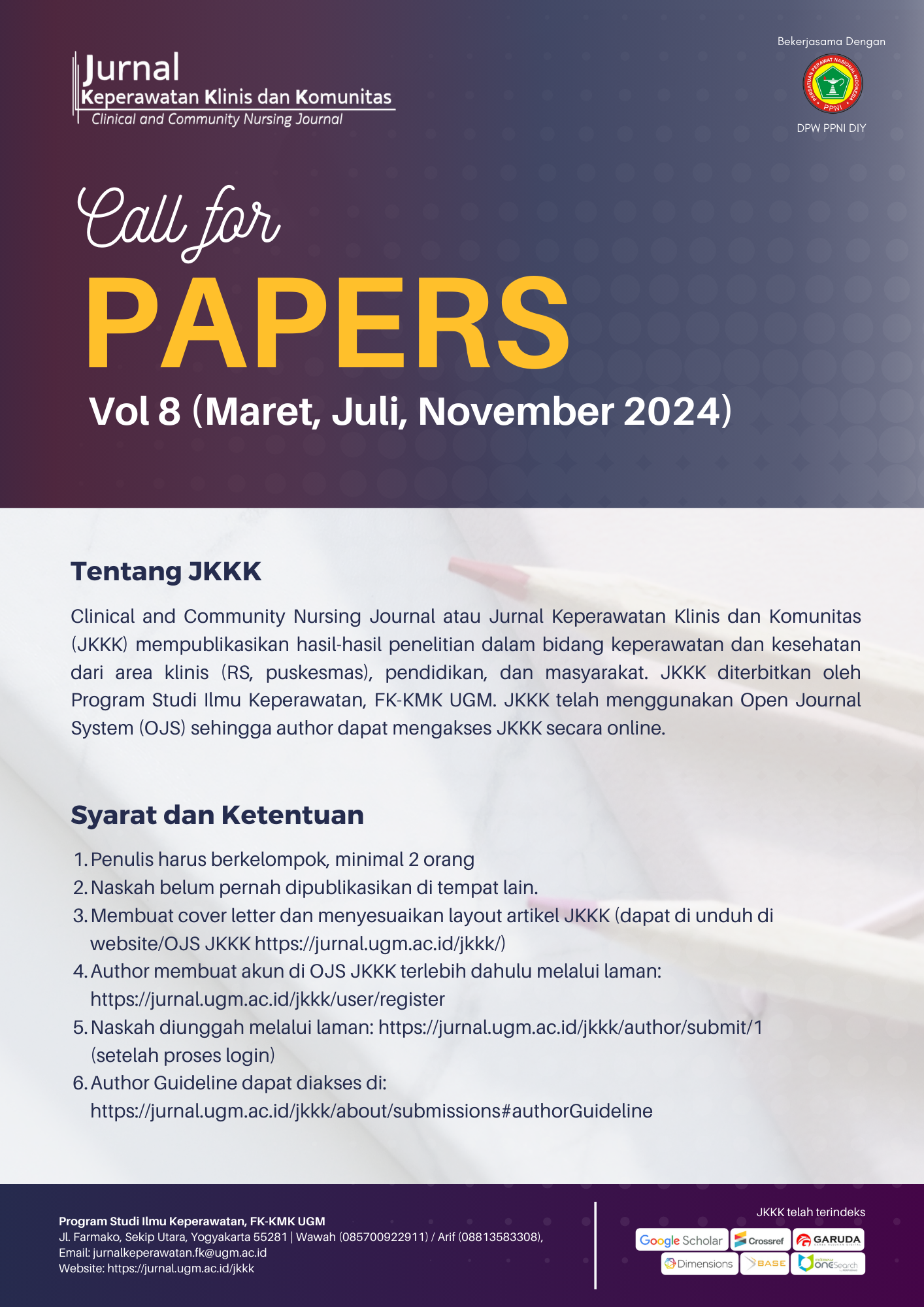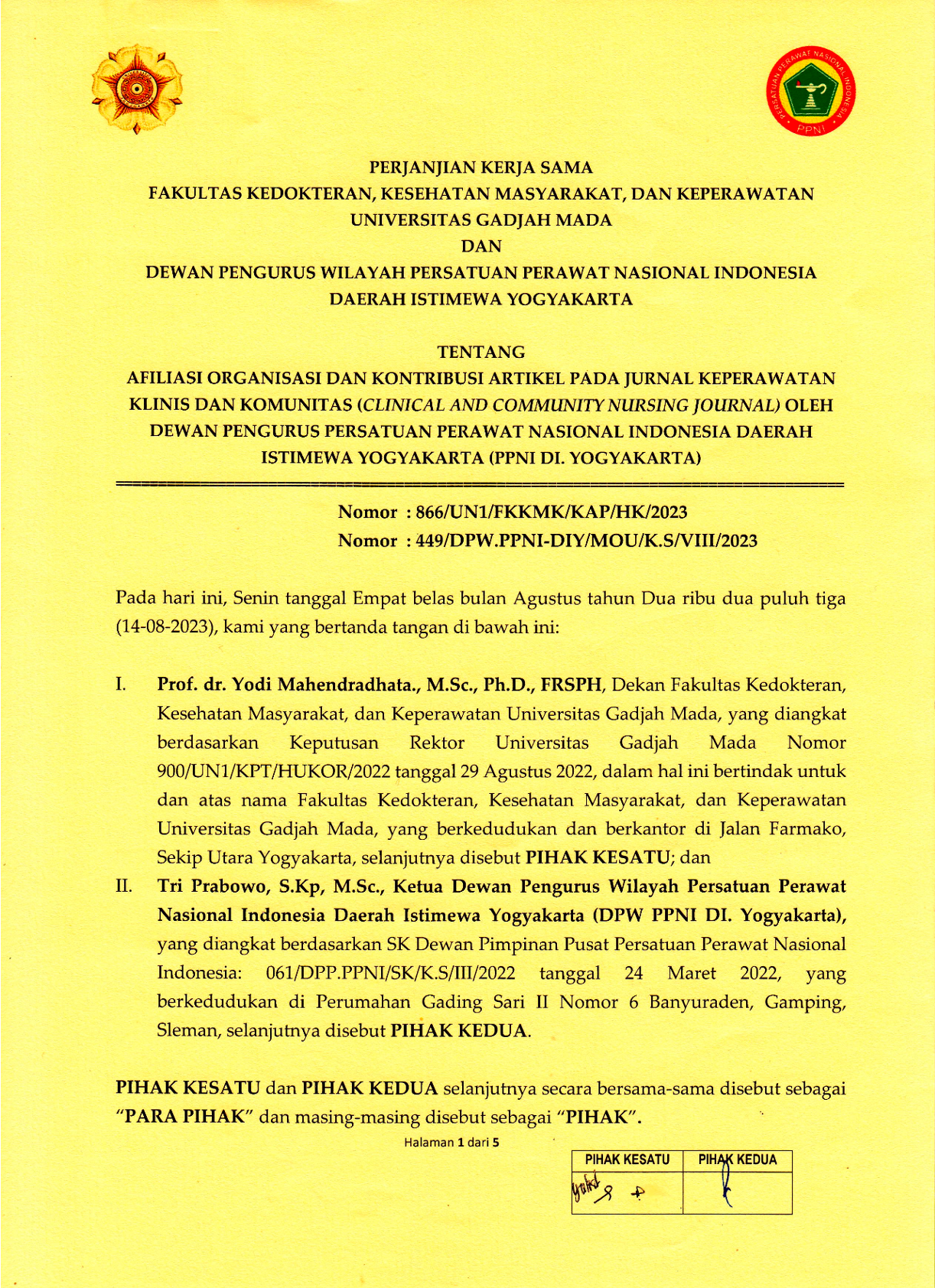Aktivitas Fisik dan Dampaknya pada Kecemasan Anak Usia Sekolah di SDN Sinduadi Timur Sleman Yogyakarta
Yuvita Erma Diana(1*), Sri Hartini(2), Anik Rustiyaningsih(3)
(1) Program Studi Ilmu Keperawatan, Fakultas Kedokteran, Kesehatan Masyarakat, dan Keperawatan, Universitas Gadjah Mada
(2) Departemen Keperawatan Anak dan Maternitas, Fakultas Kedokteran, Kesehatan Masyarakat, dan Keperawatan, Universitas Gadjah Mada
(3) Program Studi Ilmu Keperawatan, Fakultas Kedokteran, Kesehatan Masyarakat, dan Keperawatan, Universitas Gadjah Mada
(*) Corresponding Author
Abstract
Background: Anxiety affects people across all age groups including children and physical activity has demonstrated a favorable impact on diminishing this mental issue. Research about physical activity and anxiety among school-age children has not been investigated massively in Indonesia.
Objective: To investigate the impact of physical activity on anxiety levels in children.
Method: This study employs a pre-experimental design with a one-group pre-post test approach. The participants in this study consisted of children aged 7-12, who were students in grades 3-5 at SDN Sinduadi Timur, totaling 47 students. The research utilized The Revised Manifest Anxiety Scale questionnaire, self-reported physical activity data, and a response evaluation sheet. The Wilcoxon test was used for data analysis to determine the effect of anxiety before and after the physical activity intervention, specifically through body gymnastic exercises.
Result: The results indicate a significant impact of physical activity on anxiety levels. The number of participants experiencing anxiety reduces from 7 (14,89%) to 3 (6,38%). Statistical analysis demonstrates a significant difference in anxiety levels before and after the intervention, with a p value of 0,001.
Conclusion: In conclusion, this study underscores the substantial potential of engaging in physical activity to notably reduce anxiety levels in children, emphasizing the importance of promoting physical and mental well-being among this demographic.
ABSTRAK
Latar belakang: Kecemasan memengaruhi berbagai kelompok usia termasuk anak-anak dan aktivitas fisik telah membuktikan dampak positif dalam mengurangi masalah mental ini. Penelitian tentang aktifitas fisik dan kecemasan pada anak usia sekolah belum banyak dilakukan di Indonesia.
Tujuan: Untuk menyelidiki dampak aktivitas fisik pada tingkat kecemasan pada anak-anak.
Metode: Penelitian ini menggunakan desain pra-eksperimental dengan pendekatan one-group pre-post test. Partisipan dalam penelitian ini terdiri dari anak-anak berusia 7-12 tahun, yang merupakan siswa kelas 3-5 di SDN Sinduadi Timur, dengan total 47 siswa. Penelitian ini menggunakan kuesioner The Revised Manifest Anxiety Scale, data aktivitas fisik yang dilaporkan sendiri, dan lembar evaluasi respons. Uji Wilcoxon digunakan untuk analisis data kecemasan sebelum dan setelah intervensi aktivitas fisik, khususnya melalui aktivitas latihan.
Hasil: Penelitian ini menunjukkan dampak signifikan dari aktivitas fisik pada tingkat kecemasan. Jumlah partisipan yang mengalami kecemasan berkurang dari 7 (14,89%) menjadi 3 (6,38%). Analisis statistik menunjukkan perbedaan signifikan dalam tingkat kecemasan sebelum dan setelah intervensi, dengan nilai p sebesar 0,001.
Kesimpulan: Secara keseluruhan, penelitian ini menegaskan potensi besar dari keterlibatan dalam aktivitas fisik untuk secara nyata mengurangi tingkat kecemasan pada anak-anak, dengan menekankan pentingnya mempromosikan kesejahteraan fisik dan mental di pada agregat usia ini.
Keywords
Full Text:
PDFReferences
- World Health Organization. Definition of Key Terms [Internet]. c2017. [update 2013; cited 1 Februari 2017]. Available from: http://www.who.int/hiv/pub/guidelines/arv2013/intro/keyterms/en/.
- Profil Anak Indonesia. Profil Anak Indonesia. Jakarta: Kementerian Pemberdayaan Perempuan dan Perlindungan Anak (KPP&PA); 2015.
- Rapee RM, Wignall A, Spence SH, Cobham V, Lyneham H. Helping Your Anxious Child Second Edition A Step by Step Guide for Parents. USA: New Harbinger Publications; 2010.
- Anxiety and Depression Assosiation of America. Children and Teens [Internet]. c2017. [update 2017; cited 10 Februari 2017]. Available from: https://www.adaa.org/living-with-anxiety/children
- Hand C. Living with Anxiety Disorders. USA: ABDO Publishing Company; 2014.
- Lawrence D, Johnson S, Hafekost J, Boterhoven De Haan K, Sawyer M, Ainley J, Zubrick SR. The Mental Health of Children and Adolescents. Report on the second Australian Child and Adolescent Survey of Mental Health and Wellbeing. Australia: Department of Health, Canberra; 2015.
- Riset Kesehatan Dasar. Riset Kesehatan Dasar 2013. Jakarta: Kementerian Kesehatan RI; 2013.
- Doré I, O’Loughlin JL, Beauchamp G, Martineau M, Fournier L. Volume and social context of physical activity in association with mental health, anxiety and depression among youth. Preventive Medicine. 2016; 91: 344–350. http://dx.doi.org/10.1016/j.ypmed.2016.09.006
- Larun L, Nordheim LV, Ekeland E, Hagen KB, Heian F. Exercise in prevention and treatment of anxiety and depression among children and young people. Cochrane Database Syst Rev. 2006; 19(3): CD004691. doi: 10.1002/14651858.CD004691.pub2.
- Brannon L, Updegraff J.A, Feist J. Health Psychology: An Introduction to Behavior and Health Ninth Edition. United States of America: Cengage Learning; 2017
- World Health Organization. Global Recommendations on Physical Activity for Health [Internet]. c2017. [update 2011; cited 1 Februari 2017]. Available from: http://www.who.int/dietphysicalactivity/leaflet-physical-activity-recommendations.pdf.
- Kemp AH. Mechanisms Underpinning the Link Between Emotion, Physical Health and Longevity. Australia: Frontiers Media; 2017.
- Pescatello L, Arena R, Riebe D, & ThompsonP. Exercising with Anxiety and Depression. Started, Getting Programs, Aerobic Exercise [Internet]. c2013. [update 2013; cited 30 September 2017]. Available from: http://exerciseismedicine.org/assets/page_documents/EIM%20Rx%20series_Exercising%20with%20Anxiety%20and%20Depression_2.pdf
- Anderson E, Shivakumar G. Effects of exercise and physical activity on anxiety. Affective Disorders and Psychosomatic Research. 2013; 4(27). doi: 10.3389/fpsyt.2013.00027
- McDowell CP, MacDonncha C, Herring M.P. Brief report: Associations of physical activity with anxiety and depression symptoms and status among adolescents. Journal of Adolescence. 2017; 55: 1-4. doi: 10.1016/j.adolescence.2016.12.004.
- Buckworth J, Dishman RK, O’connor PJ, Tomporowski PD. Exercise Psychology. USA: Human Kinetic; 2013
- Scully D, Kremer J, Meade MM, Graham R, Dudgeon K. Physical exercise and psychological well being: a critical review. Br J Sports Med. 1998; 32(2): 111-20. doi: 10.1136/bjsm.32.2.111.
- Anxiety and Depression Assosiation of America. Exercise for Stress and Anxiety [Internet]. c2017. [update 2014; cited 10 Februari 2017]. Available from: https://www.adaa.org/living-with-anxiety/managing-anxiety/exercise-stress-and-anxiety.
- Tomporowski PD, McCullick BA, Pesce C. Enhancing Children’s Cognition With Physical Activity Games. USA: Human Kinetics; 2015.
- Lubis NL, Simanjuntak M. Perbedaan Mood Ditinjau dari Kebiasaan Berolahraga. The Journal of Medical School. 2007; 4(2).
- Lubis NL. Depresi Tinjauan Psikologis. Jakarta: Kencana; 2016.
Article Metrics
Refbacks
- There are currently no refbacks.
Copyright (c) 2020 Yuvita Erma Diana, Sri Hartini, Anik Rustiyaningsih

Jurnal Keperawatan Klinis dan Komunitas (Clinical and Community Nursing Journal)
collaborates with DPW PPNI DIY
![]()
Jurnal Keperawatan Klinis dan Komunitas (Clinical and Community Nursing Journal) is licensed under a Creative Commons Attribution-ShareAlike 4.0 International License.





